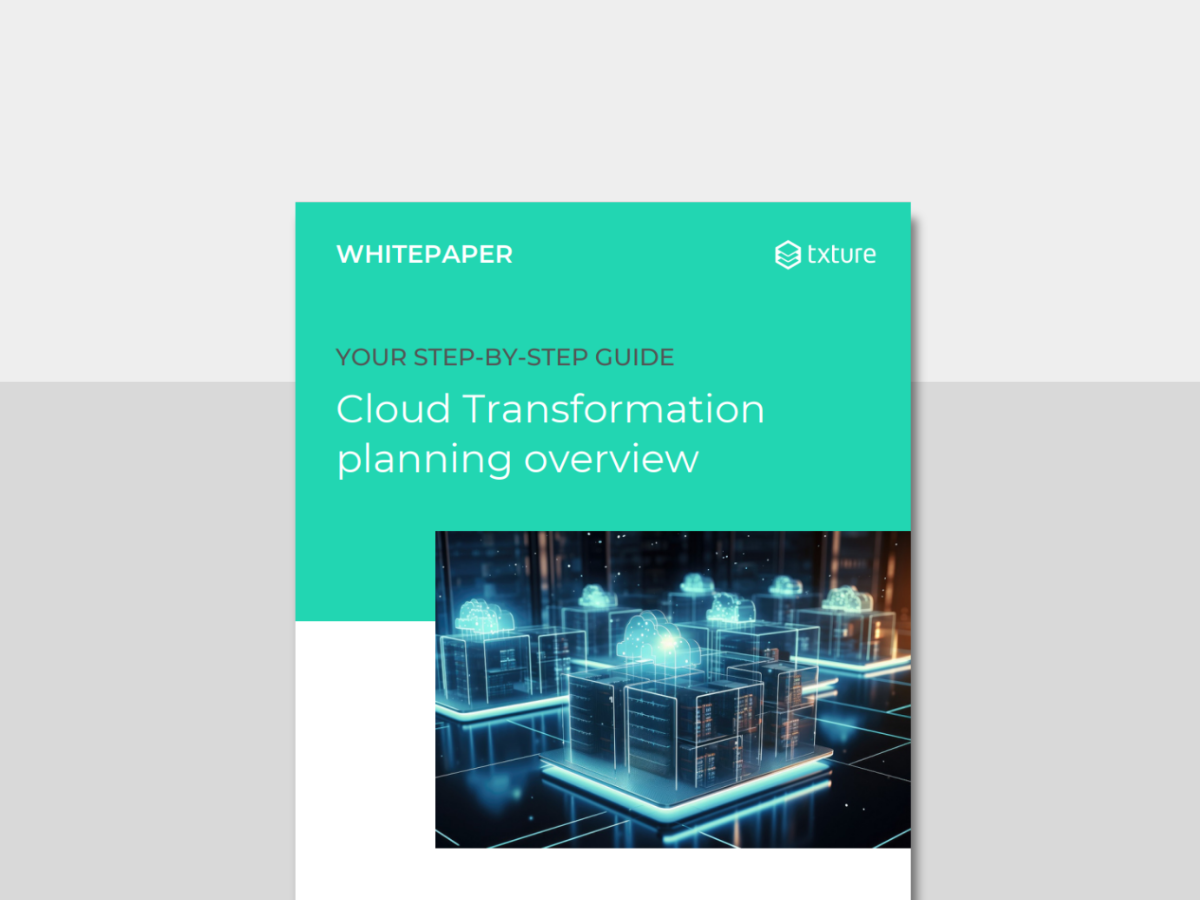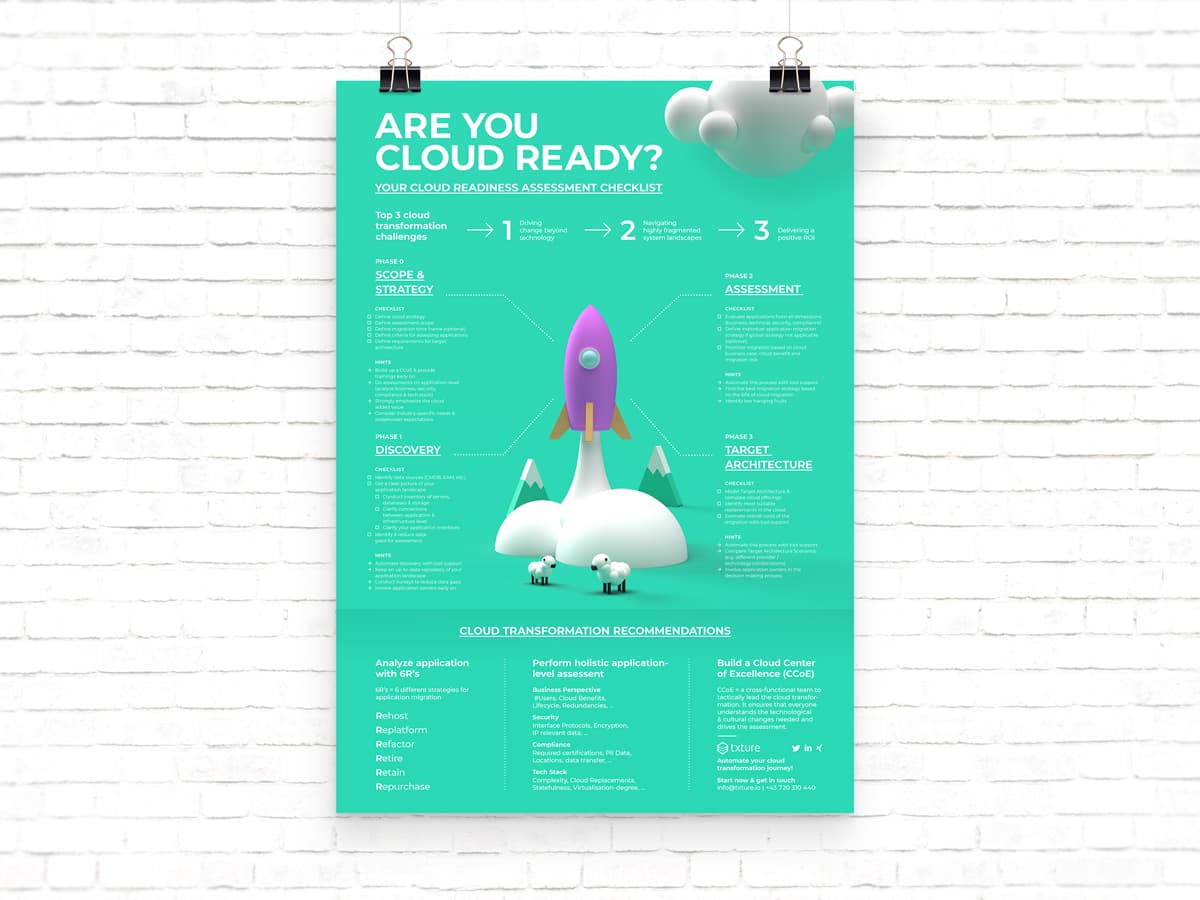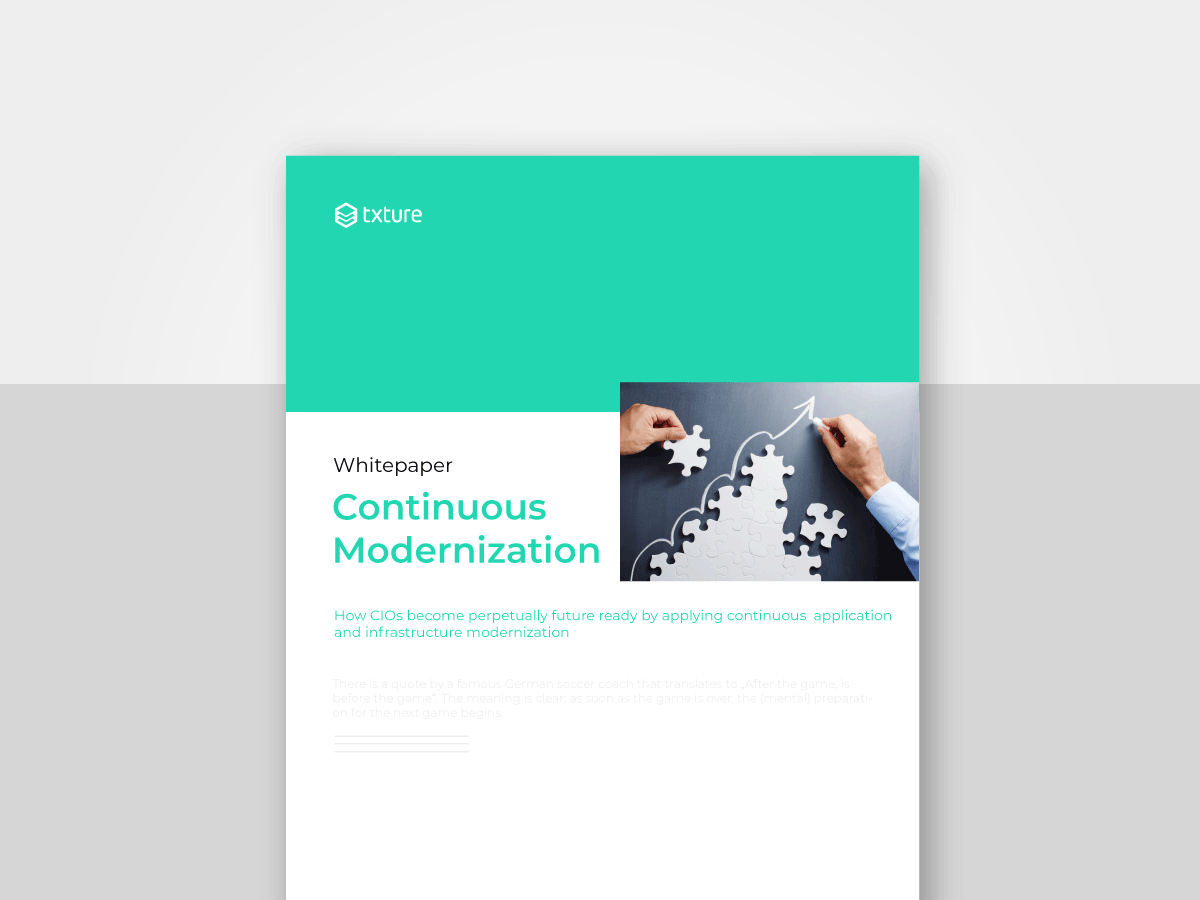Cloud Migration Overview | The 4 Phases & Best Practices

Cloud Migration means moving a company's applications, databases, digital assets and services, IT resources, and subsequently business capabilities from on-premises to the cloud, either partially, or fully. If applications and assets are already in the cloud but shall be modernized within the service portfolio of the existing cloud service provider or moved to another cloud service provider, we call this a Cloud-to-Cloud migration.
Do you need a clear overview of what your cloud transformation will look like? Download our step-by-step guide and succeed at every phase of your cloud transformation!

Step-by-step Guide: Cloud Transformation Planning
What’s the difference between a cloud transformation and a cloud migration?
In general, cloud transformation is the broader concept, referring to the entire project of moving an organization, including IT infrastructure, applications, data, and processes to the Cloud. Theoretically, cloud migration refers to only a part of a cloud transformation, describing the actual shifting towards the cloud. However, cloud migration and cloud transformation are often used synonymously.
In this blog article, we will guide you through the 4 main steps of a cloud migration.
4 Main migration phases
A cloud migration needs sound planning, a thought-through strategy and often requires the entire organization to support the process. For an organization to become cloud-based, there are four main steps to take:
- Data Collection: Collecting all relevant information and data about the as-is IT estate, looping in affected stakeholders
- Application Assessment: Assessing applications and assets for cloud readiness, migration risk, value and compliance
- Cloud Target Architecture Generation & Migration Wave Planning: Comparing possible cloud target architectures and selecting the best-suitedcloud scenario
After the selection of the preferred cloud service portfolio, the actual application migration takes place. However, the cloud transformation doesn’t end here (Spoiler: it never really ends at all, as IT needs to innovate and adapt constantly). To ensure optimal cloud usage in term of price, service types and quality and other business requirements, constant reevaluation of services is needed. This is covered in the fourth and last step: Continuous modernization and portfolio optimization.
We’ll cover each transformation phase with an extended summary, more details and additional resources (posters, videos).
 The 5 phases of a Cloud Transformation
The 5 phases of a Cloud Transformation
Pre-requisite: Strategy & business case building
Every cloud transformation project roots in one question: “What’s the business value for the company of moving to the cloud (or another cloud)?” The company's internal stakeholders need to align on their desired business outcomes to ensure a goal-oriented transformation process. Possible business values pursued by a cloud migration could be:
- Agility
- Ability to innovate faster
- Security
- Operational efficiency
- Cost savings
- Standardization
- Improving IT sustainability
To understand whether there is a business case, you first need to analyse the cost of existing on-premises or cloud estates. Then, to allow for comparison, you have to forecast target state cloud cost, know your current and future carbon footprint, determine alternative cloud services or cloud service configurations. Based on these initial evaluations, you can derive your business case. Business case building can be supported by system integrator partners or the customer facing teams of your strategic cloud service provider.
You can also read more about cloud business cases on the respective pages of AWS, Google, and Azure.
1) Data Collection
If you don’t know what you’re getting into, you can’t reasonably expect a good outcome. So when moving to the cloud, the first thing you need to do is getting an overview of all data, applications, assets etc that need to be migrated. This data may be easily available or scattered among different sources, formats and often data silos, requiring manual work from application owners and other stakeholders.
Key pieces information you need to gather are:
- General information & technical configuration: Where does the application run? Where is it deployed? Can it be licensed? How many employees use it?
- Application lifecycle: Will the application remain in use? Is it outdated?
- Business perspective: How critical is the application? Which processes does it enable? Which stakeholders are affected?
- Security: Does the application process confidential information? Is it encrypted?
If you want to learn more about the data collection phase, head over to this blog article “Understanding the IT landscape before moving to the cloud”, download our data collection poster or watch this short video:
2) Application Assessment
In this phase, you assess your data and applications for mainly two tings: First: How easy is it to migrate this asset? And second: How much will it benefit from the migration? This includes a thorough evaluation of possible migration risks and pitfalls to avoid. Organizations must assess their applications from four different perspectives to cover the full picture:
- People: Do the organization’s employees have the right skills and enough time? Do they have access to necessary software and tools? Are there conflicting priorities or interests?
- Business: Which business goals does the migration facilitate? Which costs will be lowered? Which new costs will arise? Can the business model be adjusted to leverage new possibilites?
- Security: Which identity & access management services are used? Which providers/services comply with security requirements? Which recovery & backup mechanism are required?
- Technology: Which technologies are currently used? What is transferable to the cloud? How much modification is needed? Are there cloud-native alternatives?
Based on these assessment findings, suitable migrations strategies have to be defined for every single application. The most commonly used framework are the 6R’s of Cloud Migration, referring to 6 different migration (or non-migration) strategies that can be applied. You’ve never heard of Refactoring, Rearchitecting, Repurchasing etc? In that case you should familarize yourself with the concept in our most popular blog article “All you need to know: The 6R’s of Cloud Migration”
To learn more about the application assessment phase, head over to this blog article "What is a Cloud Readiness Assessment?", watch this short application assessment video or download our poster:

Poster: Cloud Assessment Checklist
3) Cloud Target Architecture Generation & Migration Wave Planning
What does the ideal cloud estate look like and how do you get there? The target architecture describes your desired cloud architecture, containing a detailed list of services and cloud products.
These are the key steps to building a target architecture:
- 1) Set your preferences & requirements: What’s the desired scope of the migration? What’s the main goal to be achieved? Is there a preferred location or cloud provider?
- 2) Analyse the as-is infrastructure: Which are key technical properties of my applications? Which business capabilities do they support? Which levels of security and confidentiality are required?
- 3) Compare the cloud service options: What are the main features of a service? How do costs and pricing models differ? Which data center locations are available? Which tools are available to facilitate the migration?)
- 4) Define (Mix & Match) your ideal cloud target architecture containing the cloud service types, which provider(s) you want to go with, the forecasted costs and information about relevant certifications
- 5) Define an actionable migration plan: Find low hanging fruits, bundle your applications in logic migration waves, make a proper time schedule to share with internal stakeholders
If you’d like to read more about target architectures & migration planning, head over to this blog article How to define a right cloud target architecture?, download our target architecture poster or watch this short video:
4) Continuously assessing and modernizing cloud portfolios
We warned you, transforming your IT is never “over”. After the transformation is before the transformation and to keep up with ever-changing business goals and technical innovations, you have to keep an eye on your cloud portfolio. Continuous portfolio modernization can lead to significant benefits for an organization, such as increased cost-efficiency, more scalability, or the ability to innovate faster. So what are we suggesting? Keep a clear picture of your IT portfolio by continuously collecting and maintaining information about the existing applications and technology stacks. Continuously identify applications where modernization will reduce technical risk and costs while improving agility through cloud native technologies.
There are 4 steps to continuous modernization that have to be executed in a permanent loop:
- 1) Defining your goals: What does the organization need? Do you want to become cloud-native? What’s the modernization scope, what are expected outcomes?)
- 2) Collect and maintain information about your applications
- 3) Define your modernization strategy using 6R framework, specifically replatforming, refactoring, replacing / repurchasing
- 4) Execute & keep track of changes, ideally with a central data repository that keeps information in-sync with reality, all stakeholders aligned and quickly identifys bottlenecks
Curious for more details on continuous cloud modernization? Read more about target architectures & migration planning, head over to this blog article "Cloud-to-Cloud Assessment and Cost comparison", watch this short continuous modernization video or read our whitepaper:

Poster: Cloud Assessment Checklist
If you liked this condensed overview of the phases of a cloud transformation, we’d recommend you to check out our YouTube Channel or to head over to our blog for up-to-date cloud knowledge articles.
Some help would be appreciated?
To have a tool guiding you through all these different phases can be a real game-changer for a cloud transformation. Txture offers guidance and facilitating features for every single transformation phase. Read more about what Txture can do for you on our phase-specifc pages:
- Txture for business case calculation
- Txture for data collection
- Txture for application assessment
- Txture for target architecture & roadmapping
- Txture for continuous modernization
Or reach out to our experts directly:
Related posts
14.11.2023Cloud MigrationSecurity risks of cloud computing11.5.2023
Modernization StrategyModernizing legacy IT applications6.12.2022
Cloud Target ArchitectureCloud Transformation: how to define the right cloud solution architecture16.11.2022
Cloud AssessmentReady, set, cloud: What is a cloud readiness assessment?2.11.2022
Cloud KnowledgeFaces of Cloud Transformation
